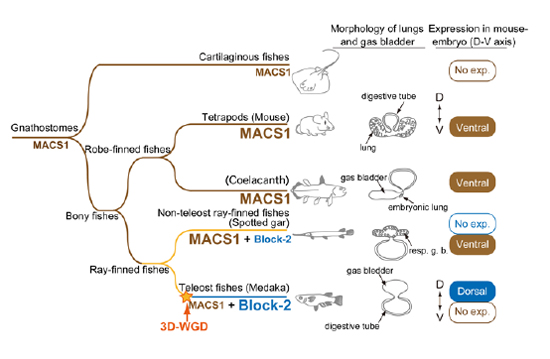Evolution of Shh endoderm enhancers during morphological transition from ventral lungs to dorsal gas bladder
![]()
Evolution of Shh endoderm enhancers during morphological transition from ventral lungs to dorsal gas bladder
Tomoko Sagai, Takanori Amano, Akiteru Maeno, Tetsuaki Kimura, Masatoshi Nakamoto, Yusuke Takehana, Kiyoshi Naruse, Norihiro Okada, Hiroshi Kiyonari, Toshihiko Shiroishi
Nature communications 8, Article number: 14300 (2017) DOI:10.1038/ncomms14300
Pressrelease (In Japanese only)
The lung and the gas bladder are most likely homologous organs, and now the gas bladder is regarded as an evolutionary modification of the lung. Transition of the lungs to the non-respiratory gas bladder for buoyancy control was crucial for the aquatic life. Because it is inferred that molecular changes in cis-regulatory element (CRE) of pleiotropic developmental genes have more often contributed to evolution of vertebrate body plan than changes in coding sequences, in this study we intended to elucidate evolution of enhancers, which was associated with morphological transition from the lungs to the gas bladder.
Shh signaling plays a crucial role for endoderm development. A Shh endoderm enhancer, MACS1, is well conserved across terrestrial animals with lungs. First, we showed that elimination of mouse MACS1 causes severe defects in laryngeal development, leading to postnatal lethality. It indicated that MACS1-directed Shh signalling is indispensable for respiratory organogenesis. Extensive phylogenetic analyses revealed that MACS1 emerged prior to the divergence of cartilaginous and bony fishes, and even euteleost fishes have a MACS1 orthologue. Meanwhile, ray-finned fishes evolved a novel conserved non-coding sequence in the neighbouring region. Transgenic assays showed that MACS1 drives reporter expression ventrally in laryngeal epithelium. This activity has been lost in the euteleost lineage, and instead, the conserved non-coding sequence of euteleosts acquired an enhancer activity to elicit dorsal epithelial expression in the posterior pharynx and oesophagus. These results implicate that evolution of these two enhancers is relevant to the morphological transition from ventral lungs to dorsal gas bladder.

Evolution of two Shh enhancers in vertebrates
Ancestral and inactive form of MACS1 appeared in the common ancestor prior to separation of lobe-finned and ray-finned fish lineages. In the tetrapods and non-teleost ray-finned fish, the inactive MACS1 evolved to the active form, which drives the Shh expression in the ventral epithelium of the prospective laryngeal structure. It is considered that the MACS1 sequence largely diverged and lost the intrinsic activity in the teleost fishes. In the meantime, ancestral form of Block-2 appeared among the non-teleost ray-finned fishes. Teleost fishes evolved the primitive Block-2 into the active form that drives the Shh expression in the dorsal epithelium of the oesophagus. resp. g. b., respiratory gas bladder; No exp., No expression.















